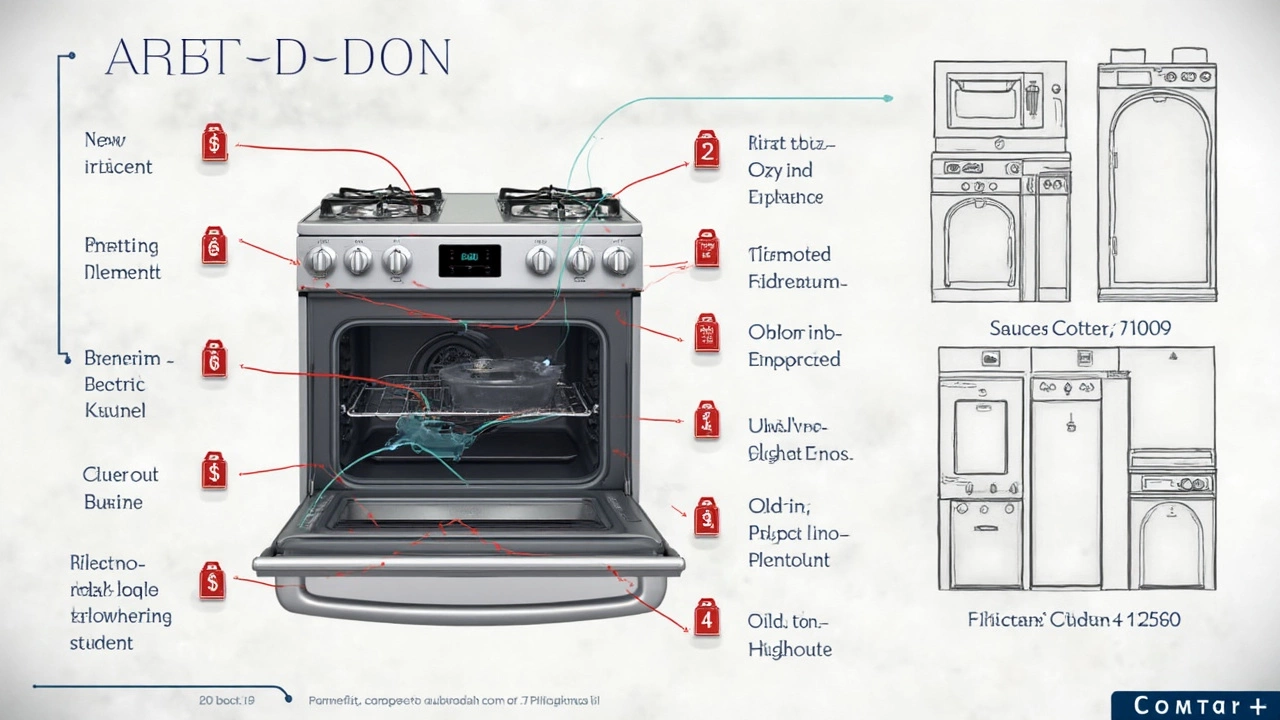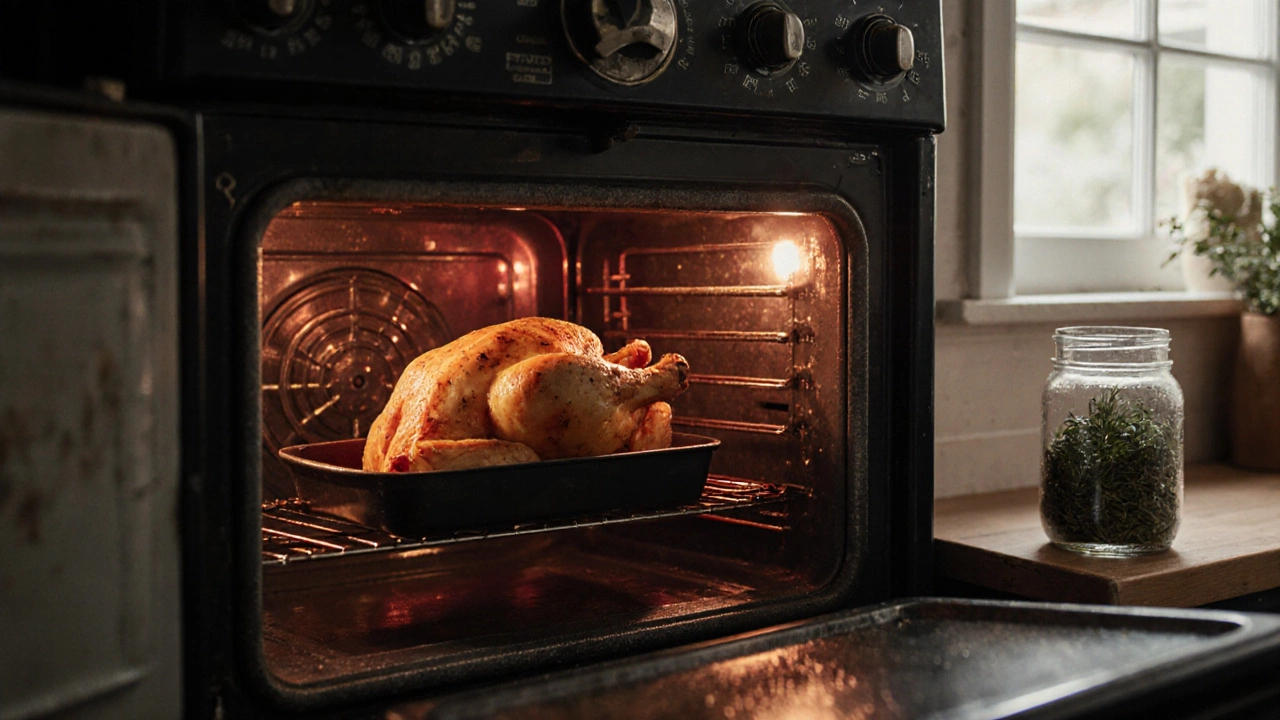
- 26 Apr 2025
- Gideon Thornton
- 0
Ten years sounds old for a kitchen appliance, right? But here’s the kicker—most electric ranges are built to last at least 13 to 15 years if you’ve been decent to them. Before you toss your oven to the curb, you want to know if patching it up is throwing money down the drain.
The truth is, the decision isn’t black and white. Some fixes are cheap and straightforward, while others can end up costing almost as much as a shiny new model. The trick is figuring out what’s actually wrong, how likely it is to fail again, and what your budget looks like. If you're staring at a stove that won't heat up or dials that spin uselessly, don't sink cash without knowing the odds.
Before calling in a repair tech—or worse, panic-buying a replacement oven—it's worth running through a checklist. What parts usually go out at this age? Are repairs simple, or are we talking major surgery? And if you do fix it, will something else break next month? You want solid, honest answers. That’s what this article covers, so you won’t regret whatever you decide to do with that 10 year old range in your kitchen.
- How Long Do Electric Ranges Really Last?
- Common Problems After 10 Years
- Repair Costs vs. Replacement Prices
- Signs You Should Say Goodbye
- When Repairs Make Sense
- How to Get the Most Out of an Old Range
How Long Do Electric Ranges Really Last?
The lifespan of an electric oven or range isn’t as short as you might think. Most models push past the 13-year mark, with the solid ones lasting up to 15 years. That’s the average you’ll find if you ask repair techs or check real-world owner surveys. Some brands are known to last even longer if you treat them well and don’t skip basic care.
Here’s a simple truth: How long your oven lives depends a lot on how much it’s used, how often you clean it, and if it’s had any major meltdowns over the years. Just like a car, gentle drivers get extra miles. If you're big on baking, roasting, or have a house full of hungry kids, those parts rack up "mileage" way faster.
To put things into real numbers, check out this quick rundown:
| Appliance | Average Lifespan (Years) |
|---|---|
| Electric range | 13 - 15 |
| Gas range | 15 - 17 |
| Dishwasher | 9 - 10 |
| Refrigerator | 10 - 13 |
Not all ovens age at the same speed. If you've done things like wipe up spills right away, avoided slamming the door, and followed safety tips, your range will likely beat the odds. But if it’s seen a decade of spills, slamming, and zero maintenance, its days might be numbered.
Keep in mind, manufacturers don’t build them like tanks anymore, but you shouldn’t assume 10 years is the end for your 10 year old range. Sometimes a small fix can buy you several more good years.
Common Problems After 10 Years
If your 10 year old range is acting up, you’re not alone—there are a few culprits that tend to pop up as these appliances age. Most electric ovens start showing their age with issues that can range from mildly annoying to total deal-breakers.
The most obvious trouble comes from the heating elements burning out. If your oven takes forever to preheat, or doesn’t get hot at all, chances are the bake or broil element has failed. Replacing these isn’t rocket science, but the part itself can cost $40 to $100, and that’s before you pay any labor.
Next up: temperature problems. You set it for 350°F but cookies come out pale or burnt? Older electric ovens often develop thermostat or sensor issues. Sometimes a recalibration gets it back on track. Other times, the sensor itself has to go. That part alone can run $30 to $80.
Don’t forget about the control board—the brains of the operation. After a decade of on-and-off cycles, these can just give up. If your oven won’t turn on or responds weirdly to commands, a fried control board may be to blame. This is one of the pricier fixes, sometimes hitting $200 or more for the part. And honestly, repair techs will tell you: if the control board dies, the rest of the range likely isn’t far behind.
Smaller stuff sneaks up too, like broken door hinges, worn-out gaskets (those rubber seals around the door), or digital displays fading out. Door problems can lead to heat leaking out and wasted electricity, while a bad seal messes with cooking times and temperatures.
If you want numbers, here’s what repair shops say are the top fixes for decade-old ranges:
| Problem | Typical Fix Cost |
|---|---|
| Heating element failure | $100 – $250 |
| Temperature sensor/thermostat | $100 – $200 |
| Control board | $200 – $400 |
| Door gasket or hinges | $50 – $150 |
One more headache? Older appliance parts can be harder to track down. Manufacturers might stop making them, so even simple repairs turn into internet scavenger hunts or settling for used pieces.
So if your electric oven is hitting that 10 year mark, keep an eye out for these common issues. Knowing what usually goes wrong makes it easier to judge if a fix is worth your cash—or if it’s just time for something new.
Repair Costs vs. Replacement Prices
If your electric oven repair bill is creeping up to half the price of a new oven, hit pause before you pay up. Most service calls just to diagnose a problem cost anywhere from $90 to $150, and that's before any labor or parts. Simple fixes like replacing a burner or switch usually run $100 to $250 total, parts and labor together. But bigger jobs—say, a busted control board—can jump north of $400 fast, especially if your oven is a fancy model.
Wondering what these numbers look like next to a new range? Entry-level electric ranges in 2025 are regularly on sale between $550 and $700 for a basic model, with mid-range options going up to $1,400 or more. If your repair bill is stacking up past $350, it’s smart to weigh those dollars against the cost of a new, more efficient range.
- Burner not working: Around $120 to $220 including parts and labor
- Broken oven element: $150 to $250
- Control board failure: $350 to $500+ (some brands much higher)
- Door latch or basic hardware issues: Usually under $150
Here’s a quick glance at typical repair costs versus buying a new appliance:
| Repair Type | Average Cost (2025 USD) |
|---|---|
| Simple part (burner, knob) | $100 - $200 |
| Oven element replacement | $150 - $250 |
| Control board replacement | $350 - $500 |
| New basic electric range | $550 - $700 |
Keep in mind, older ranges can nickel-and-dime you as more parts wear out. If this is your first major repair and the rest of your stove works fine, fixing it might be a good deal. But if different problems keep popping up every few months, your appliance lifespan might be running out and that money will stretch further on a new oven in the long run.

Signs You Should Say Goodbye
There's a point where fixing a 10 year old range doesn't make sense anymore. Sometimes, your electric oven repair bill is just the start of your headaches. Here are the main warning signs it’s time to cut your losses and shop for something new.
- Major parts are fried: If your oven needs a new control board, heating element, or glass top all at once, costs pile up fast. Some of these repairs can set you back $300–$500 each. If you’re facing more than one big fix, it’s usually not worth it.
- Repairs outpace replacement: Ever heard the 50% rule? If the repair bill is more than half the price of a new oven, start browsing sales. Medium-range electric ovens often cost $700–$1,200 new, so if a repair is $400+, you’re just throwing money away.
- Constant breakdowns: Are you calling a tech every few months or dealing with nagging issues that never really get fixed? Frequent breakdowns are a clear hint your appliance is on its last legs.
- DIY fixes don't work anymore: If small tricks—like tightening a loose knob or swapping an oven light—stop working and bigger stuff keeps breaking, it's a sign the oven's just wearing out.
- Outdated or unsafe: Some older electric ovens lack modern safety features. If you see flickering lights, scary sparks, or smell burning plastic, this might be more than a nuisance. It's a safety issue—you don't want to risk a kitchen fire.
Here’s a look at the typical repair prices so you can compare:
| Common Repair | Average Cost (USD) |
|---|---|
| Bake element | $150–$300 |
| Control board | $250–$500 |
| Glass top | $400–$600 |
| Thermostat | $100–$250 |
If you’re seeing bills racking up or parts getting harder to find, it’s often smarter (and less stressful) to invest in a new oven. Technology has improved and new models can save you a bit on your energy bill too. Don’t feel guilty—it happens to the best of kitchen gear!
When Repairs Make Sense
So, when does fixing a 10 year old range actually pay off? First, check your repair bill. If the repair will cost less than about half the price of a new stove, that’s usually considered a good bet. According to a HomeAdvisor price guide, most electric oven repair jobs run between $100 and $400. For comparison, a mid-level replacement range costs $600 to $1200 at big-box stores in 2025.
- Simple fixes—like a dead burner, a blown fuse, or a bad bake element—are nearly always worth it. Parts like heating elements or door hinges can often be swapped in 30 minutes.
- Control panel trouble? If it’s just a switch or button that doesn’t respond, the part alone may be under $100, plus labor.
- Oven not heating evenly? That usually comes down to a cheap sensor or igniter, which is straightforward for a repair tech.
If you’ve already invested in a higher-end range when you bought it, repairs make even more sense. Those luxury brands (think Bosch or GE Profile) can carry replacement parts longer and are designed to be serviced. If your range has a clean history—no frequent callouts, no mysterious electrical glitches—it’s less likely to surprise you with another issue next month.
Here are a few solid cases when spending money to fix your electric oven is a safe call:
- You haven’t skipped regular cleaning or maintenance, so it’s not gunked up inside.
- Your oven is still solid—no signs of rust, massive dents, or worn wiring.
- The issue is isolated to one burner, the oven light, or a simple digital error.
- The part you need isn’t discontinued—easy to check by searching your model number online or asking your repair tech in advance.
Sometimes, vendors or repair services offer a warranty on the replaced part or their labor. That gives you a little insurance if the problem pops back up. Also, if you’re trying to sell your home soon, a working stove can actually help your kitchen shine in a listing and save you from last-minute negotiations.
For those who like numbers, here’s a quick side-by-side look at repair vs replacement costs in 2025:
| Repair Type | Typical Cost |
|---|---|
| Heating Element Replacement | $120-$220 |
| Control Panel/Display Fix | $100-$270 |
| Igniter or Sensor Swap | $130-$200 |
| Entire New Range (Mid-Level) | $600-$1200 |
To sum it up: If the price is right, the fix is fairly simple, and your range hasn’t had a rough life, repairing just makes sense. That’ll give you more years to enjoy that oven without breaking the bank—or your daily routine.
How to Get the Most Out of an Old Range
Got a 10 year old range taking up space? Don’t write it off just yet. An electric oven at this age can still run for years with some old-fashioned TLC—if you play it smart. The trick is keeping up with maintenance and catching issues before they cost more than the oven’s worth.
Start by cleaning it inside and out. Grease, gunk, and crumbs aren’t just gross—they can burn out heating elements and mess up sensors. Every six months, take a damp cloth and mild cleaner to:
- Oven walls and cooktop (avoid scrubbing heating elements unless they’re cold and unplugged)
- Control knobs and buttons—sticky residue can mess with their function
- Door seals, which keep heat where it belongs
Door not closing tight? Sometimes just replacing the gasket (the squishy rubber seal around the door) makes a world of difference for heat efficiency. It’s cheap and you can usually do it yourself. Search for a replacement gasket for your model, watch a quick online video, and take care of it with a screwdriver and a little patience.
Another easy win: Check the heating coils or elements. If one part of your oven or cooktop just isn’t heating like it used to, look for burnt spots, splits, or warping. Replacing a burner coil or a lower bake element doesn’t take long, and it rarely costs more than $60-$100 for most models, including labor.
Not sure if your temperature readings are right? Grab a cheap oven thermometer. Sometimes, a 10 year old oven really just needs recalibration. Most ovens let you adjust the internal thermostat through the control panel—check your manual or look it up online. Even a 25-degree swing can totally change how your food turns out.
Don’t forget safety—run a quick check every few months:
- Inspect cords and plugs for frays or burn marks
- Make sure circuit breakers aren’t tripping often
- Look under and behind your electric oven for dust and debris that could overheat parts
One more thing—energy bills. If your range is guzzling more power lately, you might have an issue with a heating element or control board. According to the Department of Energy, an efficient electric oven uses about 2.3 kWh per hour of use. If yours is way higher, it’s a sign something’s off. A smart plug with energy monitoring can clue you in.
| Range Issue | DIY Fix | Cost Estimate |
|---|---|---|
| Worn Door Gasket | Replace with model-specific part | $20-50 |
| Faulty Burner Coil | Swap in new coil | $30-100 |
| Temperature Off | Recalibrate panel setting | Free |
Staying on top of these issues lets you squeeze extra years—sometimes up to five or more—out of a 10 year old range. And the best part? You won’t be gambling on an expensive fix that leaves you wishing you’d just replaced the thing.




